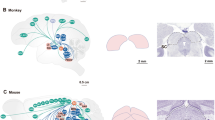Abstract
Descending vestibular pathways have been shown to influence recruitment thresholds of alpha motoneurones in both human and cat. However, whereas parallel connections to the fusimotor system have been shown in the cat, such connections have not yet been demonstrated in humans. In the present study we investigated whether vestibular inputs can influence the firing of spontaneously active muscle spindles in the leg via activation of gamma motoneurones. Unitary recordings were made from 30 muscle spindle afferents via tungsten microelectrodes inserted percutaneously into the common peroneal nerve of seated awake human subjects. Sinusoidal bipolar binaural galvanic vestibular stimulation (GVS; frequency 0.2, 0.5, 0.8 Hz, amplitude ±2 mA, 100 cycles) was applied to the mastoid processes. This continuous stimulation produced a sustained frequency-dependent illusion of “rocking in a boat” or “swinging in a hammock”. Despite these robust illusions none of the spontaneously active muscle spindles exhibited phase-locked modulation of firing during sinusoidal GVS. We conclude that this dynamic vestibular input was not sufficient to recruit gamma motoneurones, which are known to have little spontaneous activity in relaxed human muscles.


Similar content being viewed by others
References
Aniss AM, Gandevia SC, Burke D (1992) Reflex responses in active muscles elicited by stimulation of low-threshold afferents from the human foot. J Neuorphys 67:1375–1384
Aniss AM, Diener HC, Hore J, Burke D, Gandevia SC (1990) Reflex activation of muscle spindles in human pretibial muscles during standing. J Neuorphys 64:671–679
Bent LR, Bolton PS, Macefield VG (2005) Vestibular influences on spindles in relaxed human muscles. Proc Aust Neurosci Soc 15:83
Bent LR, McFadyen BJ, French Merkley V, Kennedy PM, Inglis JT (2000) Magnitude effects of galvanic vestibular stimulation on the trajectory of human walking. Neurosci Lett 279:157–160
Burke D (1981) The activity of human muscle spindle endings in normal motor behaviour. Int Rev Physiol 25:91–126
Burke D, Hagbarth KE, Lofstedt L, Wallin BG (1976) The response of human muscle spindle endings to vibration during isometric contraction. J Physiol 277:131–142
Burke D, McKeon B, Westerman RA (1980) Induced changes in the thresholds for voluntary activation of human spindle endings. J Physiol 302:171–181
Diete-Spiff K, Carli G, Pompeiano O (1967) Spindle response and extrafusal contraction on stimulation of the VIII cranial nerve or the vestibular nuclei in the cat. Pflugers Arch 293:276–280
Edin BB, Vallbo AB (1990a) Dynamic response of human muscle spindle afferents to stretch. J Neurophys 63:1279–1304
Edin BB, Vallbo AB (1990b) Classification of human muscle stretch receptor afferents: a Bayesian approach. J Neurophys 63:1314–1322
Fernandez C, Goldberg JM (1976) Physiology of peripheral neurons innervating otolith organs of the squirrel monkey. II. Directional selectivity and force–response relations. J Neurophys 39:985–995
Fernandez C, Goldberg JM (1971) Physiology of peripheral neurons innervating semicircular canals of the squirrel monkey. II. Response to sinusoidal stimulation and dynamics of peripheral vestibular system. J Neurophys 34:661–675
Fitzpatrick RC, Burke D, Gandevia SC (1994) Task-dependent reflex responses and movement illusions evoked by galvanic vestibular stimulation in standing humans. J Physiol (Lond) 478:363–372
Fitzpatrick RC, Day BL (2004) Probing the human vestibular system with galvanic stimulation. J Appl Physiol 96:2301–2316
Gandevia SC, Wilson L, Cordo PJ, Burke D (1994) Fusimotor reflexes in relaxed forearm muscles produced by cutaneous afferents from the human hand. J Physiol 479:499–508
Jones KE, Wessberg J, Vallbo AB (2001) Proprioceptive feedback is reduced during adaptation to a visuomotor transformation: preliminary findings. Neuroreport 12:4029–4033
Kennedy PM, Cresswell AG, Chua R, Inglis JT (2004) Galvanic vestibular stimulation alters the onset of gastrocnemius motor units. Muscle Nerve 30:188–194
Lund S, Pompeiano O (1965) Descending pathway with monosynaptic action on motoneurones. Experientia 21:602–603
Nafati G, Rossi-Durand C, Schmied A (2004) Proprioceptive control of human wrist extensor motor units during and attention-demanding task. Brain Res 1018:208–220
Orlovsky GN (1972) Activity of vestibulospinal neurons during locomotion. Brain Res 46:85–98
Peruch P, Borel L. Gaunet F, Thinus-Blanc G, Magnan J, Lacour M (1999) Spatial performance of unilateral vestibular defective patients in non-visual versus visual navigation. J Vestib Res 9:37–47
Pompeiano O (1972) Vestibulospinal relations: vestibular influences on gamma motoneurones and primary afferents. Prog Brain Res 37:197–232
Pompeiano O, Diete-Spiff K, Carli G (1966) Two pathways transmitting vestibulospinal influences from the lateral vestibular nucleus of Deiters to extensor fusimotor neurons. Pflugers Arch 293:272–275
Pozzo T, Levik Y, Berthoz A (1995) Head and trunk movements in the frontal plane during complex dynamic equilibrium tasks in humans. Exp Brain Res 106:327–338
Ribot E, Roll JP, Vedel JP (1986) Efferent discharge recorded from single skeletomotor and fusimotor fibres in man. J Physiol 375:251–268
Ribot-Ciscar E, Rossi-Durand C, Roll JP (2000) Increased muscle spindle sensitivity to movement during reinforcement manoeuvres in relaxed human subjects. J Physiol 532:271–282
Vallbo AB (1974) Afferent discharge from human muscle spindles in non-contracting muscles. Steady state impulse frequency as a function of joint angle. Acta Physiol Scand 90:303–318
Vallbo AB, Hagbarth LE, Torebjork HE, BurkeD (1979) Proprioceptive, somatosensory, and sympathetic activity in human peripheral nerves. Physiol Rev 59:919–957
Wall C 3rd, Oddsson LI, Patronik N, Sienko K, Kentala E (2002) Recovery trajectories of vestibulopathic subjects after perturbations during locomotion. J Vestib Res 12:239–253
Welgampola MS, Colebatch JG (2001) Vestibulospinal reflexes: quantitative effects of sensory feedback and postural task. Exp Brain Res 139:345–353
Acknowledgments
This study was supported by NSERC Post Doctoral Fellowship to LRB, and by the National Health and Medical Research Council of Australia (VGM). We express our gratitude to Dr. JB Fallon for technical and editorial contributions to this work.
Author information
Authors and Affiliations
Corresponding author
Rights and permissions
About this article
Cite this article
Bent, L.R., Bolton, P.S. & Macefield, V.G. Vestibular inputs do not influence the fusimotor system in relaxed muscles of the human leg. Exp Brain Res 180, 97–103 (2007). https://doi.org/10.1007/s00221-006-0836-5
Received:
Accepted:
Published:
Issue Date:
DOI: https://doi.org/10.1007/s00221-006-0836-5




